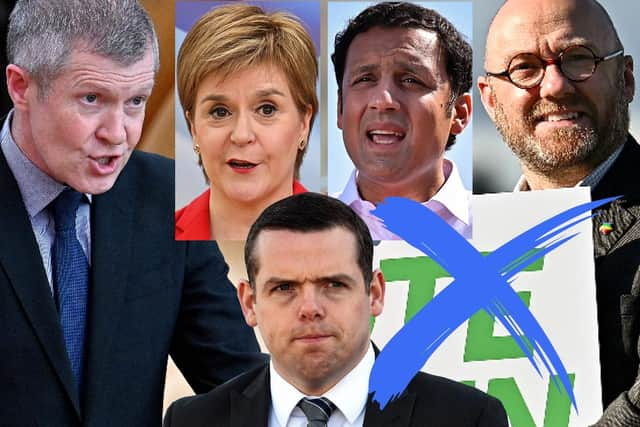Who are the leaders of Scotland’s five largest parties? What to know before Scottish Parliament election 2021
and live on Freeview channel 276
With only a few days left until people head to the polls in Scotland, the five leaders of Holyrood’s largest political parties are campaigning tirelessly ahead of the 6 May vote.
While SNP leader Nicola Sturgeon announced her plan for the first 100 days of government if her party is re-elected, Scottish Labour leader Anas Sarwar has been using a campaign bus to appeal to voters on the regional list ballot.
Advertisement
Hide AdAdvertisement
Hide AdMeanwhile, the Scottish Conservatives, under the leadership of Douglas Ross, have been calling for people to make an “anti-referendum, pro-UK majority” and the Scottish Greens have promised free bus, rail and ferry travel for young people.


And in the lead-up to the election, Scottish Liberal Democrat leader Willie Rennie has said a large group of Lib Dem MSPs would work to block a second independence referendum.
All attention may be focused on what the five parties are promising - but who are the leaders behind the policies?
Here is everything you need to know.
SNP - Nicola Sturgeon


Nicola Sturgeon, 50, is Scotland’s fifth leader - and first female leader - since the Scottish Parliament was established.
Advertisement
Hide AdAdvertisement
Hide AdBorn in Irvine, North Ayrshire, she became a member of her party when she was only 16.
She was inspired by Margaret Thatcher to get into politics, previously telling BBC Radio Four’s Women’s Hour that she felt it was “wrong” for the country to be governed by a Tory government it hadn’t elected.
After she studied law at Glasgow University, Ms Sturgeon worked as a solicitor at Drumchapel Law Centre.
She was elected to the new Holyrood parliament in 1999 as a Glasgow regional MSP when she was Scotland’s youngest parliamentary candidate.
Advertisement
Hide AdAdvertisement
Hide AdMs Sturgeon became Alex Salmond’s deputy leader after his victory in 2004. With Mr Salmond an MP in Westminster, Ms Sturgeon led the SNP contingent in Holyrood for almost three years.
Then, after the SNP’s 2007 election win, she became Scotland’s deputy first minister and health secretary.
And her electoral success continued as she spearheaded the 2011 SNP campaign when the party won an unprecedented majority at Holyrood.
When “No” won during the Scottish independence referendum of 2014, which Ms Sturgeon oversaw as the country’s “Yes Minister”, Mr Salmond stepped down as first minister and leader of the SNP.
Advertisement
Hide AdAdvertisement
Hide AdThere was no competition, with Ms Sturgeon accepting the leadership role in November that year.
She led the party into the 2015 general election, which returned unprecedented results as the SNP took a landslide 56 out of the 59 seats in Scotland.
And the 2016 Holyrood election, when the party won more than a million votes and a record 59 out of the 73 constituency seats, cemented Ms Sturgeon’s personal popularity in Scotland.
Recently, she came under scrutiny during an inquiry into whether she broke the ministerial code over her involvement in the Alex Salmond saga.
Advertisement
Hide AdAdvertisement
Hide AdHowever, an independent inquiry by senior Irish lawyer James Jamilton cleared the First Minister of breaching the code by misleading the Scottish Parliament.
The SNP, under Ms Sturgeon’s leadership, are now seeking an overall majority in the 2021 Scottish election to gain a strong mandate for a second independence referendum.
In her personal life, the First Minister has been married to Peter Murrell for 10 years, who is also chief executive of the SNP.
Scottish Conservatives - Douglas Ross
Douglas Ross, 38, was born in Aberdeen and attended Forres Academy and the Scottish Agricultural College.
Advertisement
Hide AdAdvertisement
Hide AdBefore his move into politics, he worked as a dairyman at local farms.
In 2007, he represented the Fochabers-Lhanbryde ward as a member of Moray Council.
He then stood for the Conservatives in a series of elections for Westminster and Holyrood, and became an MSP via the Highlands and Islands regional list in 2016.
But his time as Holyrood was short lived, as he won a seat at Westminster in the following year’s general election.
Advertisement
Hide AdAdvertisement
Hide AdThere was controversy during his first term as an MP, when he apologised for saying “tougher enforcement against Gypsy travellers" would be his priority if he ever became prime minister.
Yet he retained his Westminster seat in the 2019 General Election and was then named Parliamentary Under-Secretary of State for Scotland - a post he quit in May 2020 amid the row over Mr Johnson’s aide Dominic Cummings.
Cummings defended travelling 260 miles from London to County Durham during the first Covid lockdown, but Mr Ross said he had “trouble” with parts of his explanation and became the first government minister to resign over the incident.
He was announced as the new leader of the Scottish Conservatives in August 2020, following Jackson Carlaw’s resignation after only six months in the position.
Advertisement
Hide AdAdvertisement
Hide AdBut despite his rise through the ranks of the Tories, Mr Ross has not always supported the party.
Instead, he was a member of the Scottish Liberal Democrats and gave the party his first vote.
Mr Ross has also juggled his time as a member of parliament with a career as a qualified football referee, acting as a linesman in many high profile fixtures.
But the Tory leader has often been accused of prioritising his job as a linesman over his duties as an MP.
Scottish Labour - Anas Sarwar
Advertisement
Hide AdAdvertisement
Hide AdAnas Sarwar had already stood against Richard Leonard in Scottish Labour’s 2017 leadership election, but finally became leader of the party in February of this year - less than three months before the Holyrood election.
Mr Sarwar, 37, was born in Glasgow and joined Scottish Labour at the age of 16.
His dad, Mohammad Sarwar, was the UK’s first ever Muslim MP and held the Glasgow Central seat for the party between 1997 and 2010, until his son succeeded him.
After studying dentistry at the University of Glasgow, Mr Sarwar practiced as a dentist for five years, before becoming an MP.
Advertisement
Hide AdAdvertisement
Hide AdIn 2010, he was elected to represent Glasgow Central, a seat he held for five years.
A year later he was voted as deputy leader of the Scottish Labour Party, leading the party’s campaign against Scottish independence in the lead up to the 2014 referendum.
Mr Sarwar was then elected as a list MSP for Glasgow in 2016, after the Glasgow Central seat was won by the SNP.
He was chosen by then-leader Kezia Dugdale to work as Shadow Cabinet Secretary for Health.
Advertisement
Hide AdAdvertisement
Hide AdIn the 2017 leadership election Mr Sarwar, who faced questions about his family’s cash-and-carry firm advertising jobs that paid less than the “real” living wage, was soundly defeated by the Jeremy Corbyn-backed Richard Leonard.
When he won the same contest this year, Mr Sarwar became the first non-white leader of a major political party in the UK.
In the past, he has spoken of the racism he has experienced as a politician, including death threats made against his family.
Mr Sarwar is hoping to beat the Scottish Tories in the May election so his party becomes the second largest at Holyrood.
Scottish Greens - Patrick Harvie and Lorna Slater
Patrick Harvie
Advertisement
Hide AdAdvertisement
Hide AdThe Scottish Greens is co-led by both Patrick Harvie and Lorna Slater, with the party operating a system where a male and female work together.
Mr Harvie, 48, born in Vale of Leven, studied at Dumbarton Academy before attending Manchester Metropolitan University.
Before he was first elected to the Glasgow list region in 2003, the Greens co-leader was an equality and LGBT health campaigner.
From 1997, he worked at Lanarkshire Health Board's sexual health organisation PHACE Scotland.
Advertisement
Hide AdAdvertisement
Hide AdIn his first two years in Holyrood, he was Green Party Spokesperson for Justice and Communities before becoming Spokesperson for Justice, Communities, Europe and Constitutional Affairs.
Mr Harvie has been co-leader of the Scottish Greens since 2008, and he is the first openly bisexual party leader in Scotland.
But before he became leader, he was heavily criticised over calls for a ban on state funding for Catholic schools when he supported the Gay and Lesbian Humanist Association which claimed gay children are at risk in Catholic schools due to bullying.
Outside of politics, Mr Harvie is Honorary Vice-President of the Gay and Lesbian Humanist Association and is a member of Greenpeace, Friends of the Earth and Amnesty International.
Advertisement
Hide AdAdvertisement
Hide AdHe also ran for Rector of the University of Glasgow in 2008.
Lorna Slater
Meanwhile, Ms Slater, who was born in Canada before moving to Scotland, was elected as co-leader of the Scottish Greens alongside Mr Harvie in August 2019.
As well as her role in Scottish politics, Ms Slater is an electro-mechanical engineer, and works as an engineering project manager for Orbital Marine Power which develops floating tidal stream turbines.
After her election, Ms Slater said she looked forward to using her expertise in marine renewable energy and manufacturing when her party proposed a Scottish Green New Deal.
Advertisement
Hide AdAdvertisement
Hide AdIn 2019, she was selected to take part in the Homeward Bound leadership programme, which involved her spending a year studying leadership and climate change including a three-week visit to Antarctica to see the effects of the crisis in person.
During the May election, Ms Slater will be contesting the Edinburgh Northern and Leith constituency seat in the Scottish Parliament.
The Scottish Greens co-leader will also be second on the Lothian regional list for the party.
In her personal life, Ms Slater shares a 15-year-old pet bearded dragon called Bellamy with her husband.
Scottish Liberal Democrats - Willie Rennie
Advertisement
Hide AdAdvertisement
Hide AdWillie Rennie is leader of the Scottish Lib Dems, the joint fourth largest political party in the Scottish Parliament.
The 55-year-old, who was born in Fife, has been the MSP for the North Fife Constituency since 2016.
Before that, he was the MSP for Mid Scotland and Fife from May 2011.
He became leader of the party in 2011, following the resignation of Tavish Scott when the Lib Dems lost 11 seats down to 6 in the general election.
Advertisement
Hide AdAdvertisement
Hide AdAs well as leading the pro-Union party, he is its chief whip and spokesperson on finance.
Before he got into politics, Mr Rennie grew up in the village of Strathmiglo and lived above the local shop that his family ran.
He studied biology at Paisley College of Technology, and when he was a student he headed up the Scottish Young Liberal Democrats.
Mr Rennie then went on to work for the party as a campaign manager in England, following his graduation.
Advertisement
Hide AdAdvertisement
Hide AdHis big break into politics came when he was elected MP for Dunfermline and West Fife in 2005.
He was also a member of the House of Commons Defence Select Committee, Shadow Defence Minister and Chairman of the Lib Dems' Campaigns and Communications Committee.
But Mr Rennie lost his seat to Scottish Labour in the May 2010 general election and subsequently turned his sights to Holyrood.